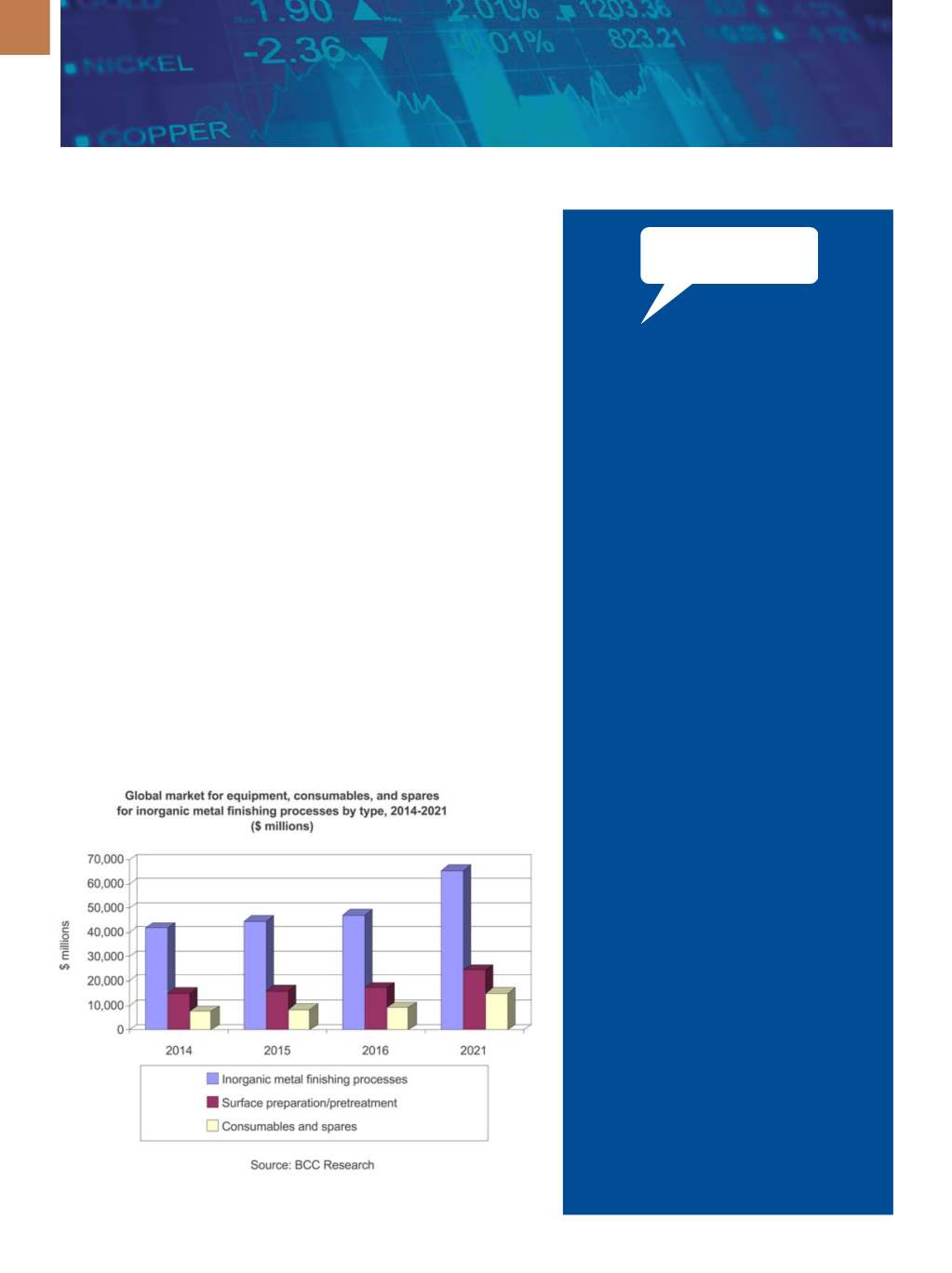

A D V A N C E D M A T E R I A L S & P R O C E S S E S | N O V E M B E R / D E C E M B E R 2 0 1 5
6
MARKET SPOTLIGHT
FEEDBACK
METAL FINISHING MARKET CONTINUES GROWTH
According to a new report
from BCC Research, Wellesley,
Mass., the world market for equip-
ment, consumables, and spares
for inorganic metal finishing pro-
cesses was valued at $64.5 billion
in 2014 and is expected to reach
$68.9 billion in 2015. The market
is further expected to increase at a
compound annual growth rate of
7.4% from $73.6 billion in 2016 to
$105 billion in 2021. Metal finish-
ing is defined as the deposition of
a coating, which may be metallic
or nonmetallic, onto a metallic
substrate. The market compris-
es surface preparation/pretreat-
ment, inorganic metal finishing,
and consumables and spares.
Worldwide activity in the en-
ergy production, transportation,
and storage sectors is a key driver
of increased sales formajor compa-
nies involved in this market. Major
projects related to the production
and transportation of energy, in-
cluding traditional and alternative
power generation facilities, oil and
gas drilling, pipelines, infrastruc-
ture construction, and shipbuild-
ing are under way in all areas of
the world, with a specific focus on
emerging markets including the
Middle East, Russia, Latin America,
Asia-Pacific, and Eastern Europe.
Global Markets and Technol-
ogies for Inorganic Metal Finishing
Processes
examines global and re-
gional markets for various types of
inorganic metal finishing technol-
ogies. Market dynamics, growth
drivers, inhibitors, opportunities,
and forecasts of trends and rev-
enue through 2021 are provid-
ed.
For more information, visit
bccresearch.com.
RESPECT THE TECHS
Thank you for the recent news about NASA’s
progress on welding the Orion crewmodule at
the Michoud Assembly Facility (
AM&P eNews,
Sept. 16).
In the article, the word
engineers
is
used in two places where
technicians
is more
accurate. The first sentence says that “engineers
have welded together the first two segments
of the Orion crewmodule,” but in truth the
welding was done by highly skilled and certified
technicians, as the last paragraph states.
In the engineering world, we
engineers
sometimes get credit for things we did not do at
the expense of those who did, the
technicians
.
Semantics for sure, yet there is a bias—ever
for the engineer—with the lowly technician an
afterthought. In America today, we tend to favor
education and book smarts. Our schools have
abandoned the old idea of trade school, where
a technician’s natural gifts are nurtured as a
hands-on trade.
There is little cultural respect for the plumb-
er, electrician, or welder although they are the
craftsmen, artisans, and doers of what needs to
be done. I hope ASMwill consider this and begin
to breathe respect into your readers’ minds
that to be a technician is to be an artisan, a vital
member of the engineering team, not optional
or easily interchanged—valid in their own right.
The engineer-technician skillset represents
the knowing-doing capability. If wisdom is our
guide, we must honor our intelligent, hands-on
doers as much as our intelligent, conceptual
knowers. In the Venn diagramwhere a techni-
cian’s smarts overlap with an engineer’s smarts
lies a sweet spot—where getting the job done,
and done right, makes the world a better place.
Dan Keenan
We welcome all comments
and suggestions. Send letters to
frances.richards@asminternational.org.


















